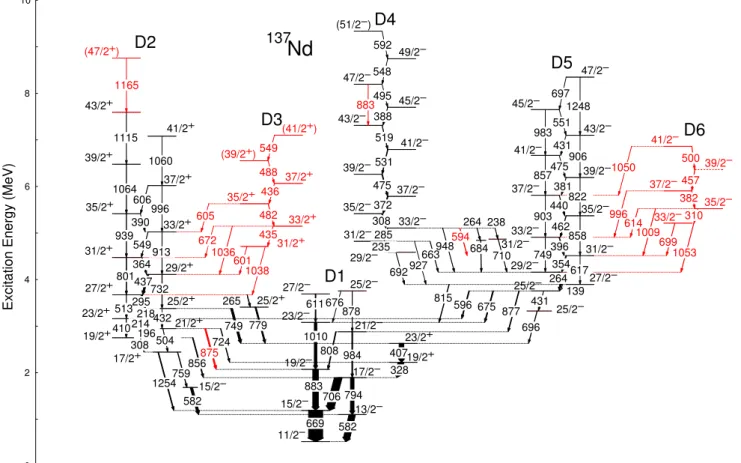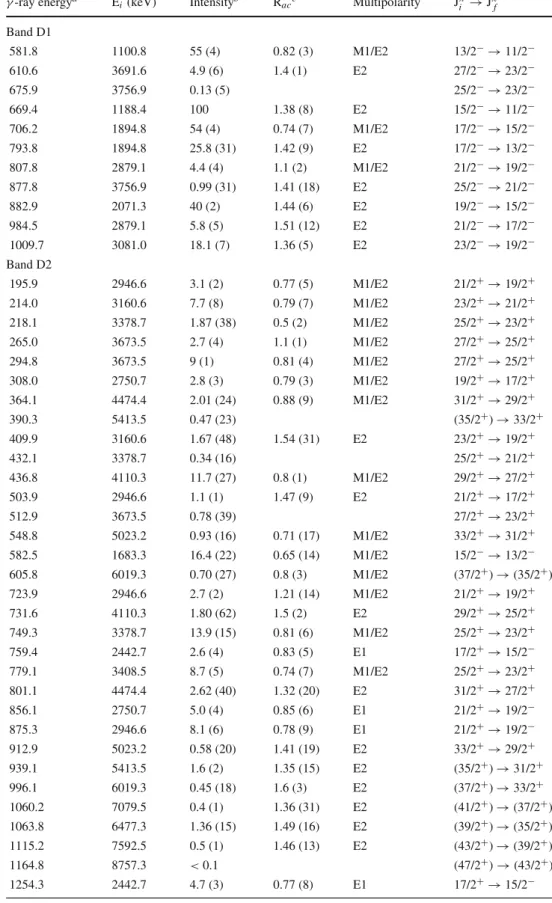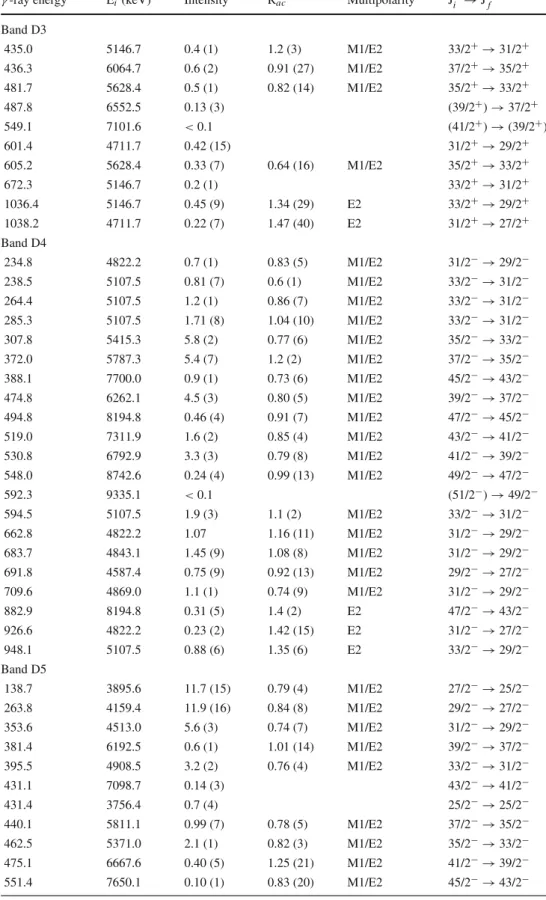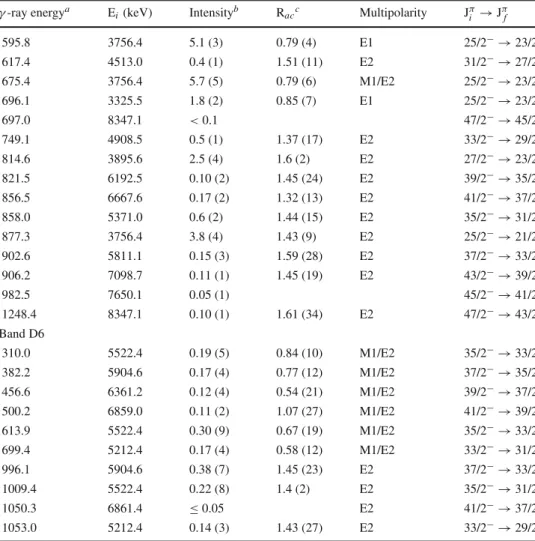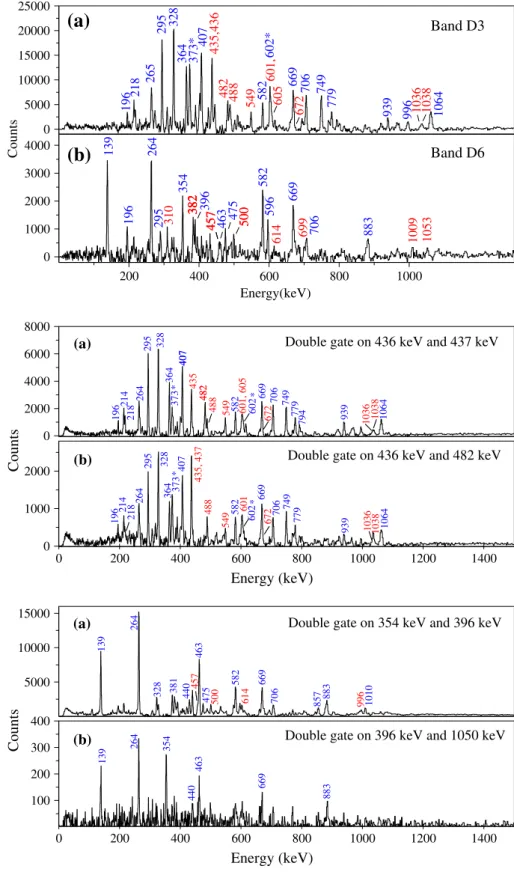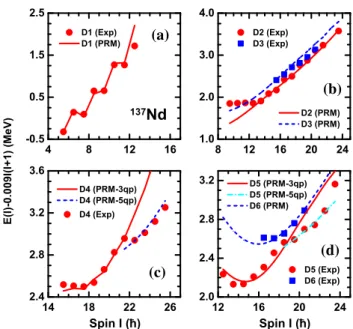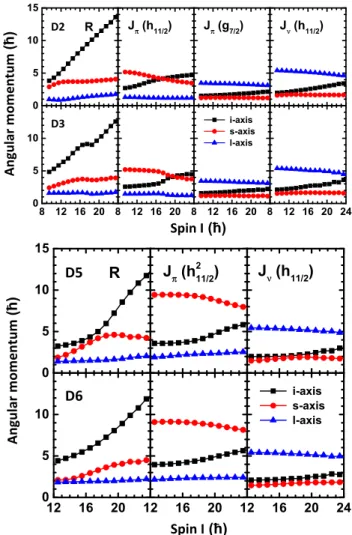https://doi.org/10.1140/epja/s10050-020-00218-5
Regular Article - Experimental Physics
Multiple chiral bands in 137 Nd
C. M. Petrache1,a, B. F. Lv2,b, Q. B. Chen3, J. Meng4,5, A. Astier1, E. Dupont1, K. K. Zheng1, P. T. Greenlees6, H. Badran6, T. Calverley6,7, D. M. Cox6,8, T. Grahn6, J. Hilton6,7, R. Julin6, S. Juutinen6, J. Konki6,9,
J. Pakarinen6, P. Papadakis6,10, J. Partanen6, P. Rahkila6, P. Ruotsalainen6, M. Sandzelius6, J. Saren6, C. Scholey6, J. Sorri6,11, S. Stolze6,12, J. Uusitalo6, B. Cederwall13, A. Ertoprak13, H. Liu13, S. Guo2, J. G. Wang2, X. H. Zhou2, I. Kuti14, J. Timár14, A. Tucholski15, J. Srebrny15, C. Andreoiu16
1Centre de Sciences Nucléaires et Sciences de la Matière, CNRS/IN2P3, Université Paris-Saclay, Bât. 104-108, 91405 Orsay, France
2Institute of Modern Physics, Chinese Academy of Sciences, Lanzhou 730000, China
3Physik-Department, Technische Universität München, 85747 Garching, Germany
4State Key Laboratory of Nuclear Physics and Technology, School of Physics, Peking University, Beijing 100871, China
5Yukawa Institute for Theoretical Physics, Kyoto University, Kyoto 606-8502, Japan
6Department of Physics, University of Jyväskylä, 40014 Jyvaskyla, Finland
7The Oliver Lodge Laboratory, Department of Physics, University of Liverpool, Liverpool L69 7ZE, UK
8Department of Mathematical Physics, Lund Institute of Technology, 22362 Lund, Sweden
9CERN, 1211 Geneva 23, Switzerland
10STFC Daresbury Laboratory, Daresbury, Warrington WA4 4AD, UK
11Sodankylä Geophysical Observatory, University of Oulu, 99600 Sodankylä, Finland
12Physics Division, Argonne National Laboratory, Argonne, IL 60439, USA
13KTH Department of Physics, 10691 Stockholm, Sweden
14Institute for Nuclear Research, Hungarian Academy of Sciences, Pf. 51, 4001 Debrecen, Hungary
15Heavy Ion Laboratory, University of Warsaw, Pasteura 5a, 02-093 Warsaw, Poland
16Department of Chemistry, Simon Fraser University, Burnaby, BC V5A 1S6, Canada
Received: 8 June 2020 / Accepted: 4 August 2020
© Società Italiana di Fisica and Springer-Verlag GmbH Germany, part of Springer Nature 2020 Communicated by Navin Alahari
Abstract Two new bands have been identified in 137Nd from a high-statistics JUROGAM II gamma-ray spectroscopy experiment. Constrained density functional theory and parti- cle rotor model calculations are used to assign configurations and investigate the band properties, which are well described and understood. It is demonstrated that these two new bands can be interpreted as chiral partners of previously known three-quasiparticle positive- and negative-parity bands. The newly observed chiral doublet bands in137Nd represent an important support to the existence of multiple chiral bands in nuclei. The present results constitute the missing stone in the series of Nd nuclei showing multiple chiral bands, which becomes the most extended sequence of odd–even and even- even nuclei presenting multiple chiral bands in the Segré chart.
ae-mail:costel.petrache@csnsm.in2p3.fr(corresponding author)
be-mail:lvbingfeng@impcas.ac.cn(corresponding author)
1 Introduction
The nuclei of theA≈130 mass region constitute the largest ensemble of chiral nuclei [1] in the chart of the nuclides [2]. Reviews of the experimental results and their theoretical interpretation can be found in Refs. [3–7]. Bands built on con- figurations involving three-, four- and six-quasiparticles have been observed in this mass region (133La [8],133Ce [9],135Nd [10,11],136Nd [12,13] and138Nd [14–16]). The present work is devoted to the study of chirality in137Nd, the odd–even neighbor of135Nd and136Nd, in which multiple chiral dou- blet (MχD) [17] bands have been recently identified [11–
13]. Prior to this work, the137Nd nucleus has been investi- gated both experimentally [18,19,22–24] and theoretically [25]. Two new dipole bands are identified at medium spins, which are interpreted as chiral partners of previously known three-quasiparticle positive- and negative-parity bands. The interpretation of the three-quasiparticle bands and the chi- rality, previously investigated using the interacting boson model plus broken pairs [25], are revisited. The resemblance between the new negative-parity chiral doublet of137Nd with that known in135Nd and133Ce, gives strong support to the
interpretation in terms of chiral vibration at low spin, and to the invoked transition between chiral vibration and chiral rotation in the odd–even Nd nuclei [26]. The existence of two chiral doublet bands in137Nd also gives a strong support to the existence of the MχD phenomenon in the A ≈130 mass region, which presents, in addition to133Ce, in the most extended sequence of nuclei including both odd–even and even–even nuclei, from135Nd to138Nd. The band structure is discussed within the constrained covariant density func- tional theory (CDFT) framework [17,27] and the particle rotor model (PRM) recently developed to include multi-j configurations, which is a powerful tool in the investigation of the 3D chiral geometry in nuclei [13,28,29]. The present experimental results are obtained from the same data set from which were obtained the results of Refs. [11,12,22,30,31].
2 Experimental results
High-spin states in137Nd were populated using the100Mo (40Ar,3n) reaction at a beam energy of 152 MeV, pro- vided at the Accelerator Laboratory of the University of
Jyväskylä, Finland. A self-supporting enriched100Mo foil of 0.50 mg/cm2thickness was used as a target. The JUROGAM II array [32] consisting of 24 clover and 15 coaxial tapered germanium detectors placed at the target position was used to detect promptγ-rays. A total of 5.1×1010promptγ-ray coincidence events with fold≥3 were collected. All the data were recorded by the triggerless Total Data Readout (TDR) data acquisition [33] and the events were time-stamped using a 100 MHz clock. The data were sorted using the GRAIN code [34]. Fully symmetrized, three-dimensional (Eγ-Eγ- Eγ) and four-dimensional (Eγ-Eγ-Eγ-Eγ) matrices were analyzed using theradware[35,36] analysis package.
The partial level scheme of 137Nd showing in red the newly identified bands is given in Fig. 1. Spin and par- ity assignments for newly observed levels are based on the measured two-point angular correlation (anisotropy) ratios Rac[20,21]. To extract the Racvalues, the data were sorted intoγ-γmatrices constructed by sorting prompt coincidence events with the detectors mounted at (133.6◦ and 157.6◦) versus (all angles) and (75.5◦and 104.5◦) versus (all angles) combinations, by setting the same energy gates on the (all angles) projection spectrum in both matrices, and projecting
Fig. 1 Partial level scheme of137Nd showing, in addition to the pre- viously known bands D1, D2 and D5, the newly identified bands D3 and D6, and 594-, 875-, 883- and 1165-keV transitions (marked in red).
Note that the 39/2−level of band D6 is dashed because the order of the 457- and 500-keV transitions is not fixed
Table 1 Experimental information including theγ-ray energies, energies of the initial levels Ei, intensities Iγ, Rac, multipolarities, and the spin-parity assignments to the observed states in137Nd
γ-ray energya Ei(keV) Intensityb Racc Multipolarity Jπi →Jπf Band D1
581.8 1100.8 55 (4) 0.82 (3) M1/E2 13/2−→11/2−
610.6 3691.6 4.9 (6) 1.4 (1) E2 27/2−→23/2−
675.9 3756.9 0.13 (5) 25/2−→23/2−
669.4 1188.4 100 1.38 (8) E2 15/2−→11/2−
706.2 1894.8 54 (4) 0.74 (7) M1/E2 17/2−→15/2−
793.8 1894.8 25.8 (31) 1.42 (9) E2 17/2−→13/2−
807.8 2879.1 4.4 (4) 1.1 (2) M1/E2 21/2−→19/2−
877.8 3756.9 0.99 (31) 1.41 (18) E2 25/2−→21/2−
882.9 2071.3 40 (2) 1.44 (6) E2 19/2−→15/2−
984.5 2879.1 5.8 (5) 1.51 (12) E2 21/2−→17/2−
1009.7 3081.0 18.1 (7) 1.36 (5) E2 23/2−→19/2−
Band D2
195.9 2946.6 3.1 (2) 0.77 (5) M1/E2 21/2+→19/2+
214.0 3160.6 7.7 (8) 0.79 (7) M1/E2 23/2+→21/2+
218.1 3378.7 1.87 (38) 0.5 (2) M1/E2 25/2+→23/2+
265.0 3673.5 2.7 (4) 1.1 (1) M1/E2 27/2+→25/2+
294.8 3673.5 9 (1) 0.81 (4) M1/E2 27/2+→25/2+
308.0 2750.7 2.8 (3) 0.79 (3) M1/E2 19/2+→17/2+
364.1 4474.4 2.01 (24) 0.88 (9) M1/E2 31/2+→29/2+
390.3 5413.5 0.47 (23) (35/2+)→33/2+
409.9 3160.6 1.67 (48) 1.54 (31) E2 23/2+→19/2+
432.1 3378.7 0.34 (16) 25/2+→21/2+
436.8 4110.3 11.7 (27) 0.8 (1) M1/E2 29/2+→27/2+
503.9 2946.6 1.1 (1) 1.47 (9) E2 21/2+→17/2+
512.9 3673.5 0.78 (39) 27/2+→23/2+
548.8 5023.2 0.93 (16) 0.71 (17) M1/E2 33/2+→31/2+
582.5 1683.3 16.4 (22) 0.65 (14) M1/E2 15/2−→13/2−
605.8 6019.3 0.70 (27) 0.8 (3) M1/E2 (37/2+)→(35/2+)
723.9 2946.6 2.7 (2) 1.21 (14) M1/E2 21/2+→19/2+
731.6 4110.3 1.80 (62) 1.5 (2) E2 29/2+→25/2+
749.3 3378.7 13.9 (15) 0.81 (6) M1/E2 25/2+→23/2+
759.4 2442.7 2.6 (4) 0.83 (5) E1 17/2+→15/2−
779.1 3408.5 8.7 (5) 0.74 (7) M1/E2 25/2+→23/2+
801.1 4474.4 2.62 (40) 1.32 (20) E2 31/2+→27/2+
856.1 2750.7 5.0 (4) 0.85 (6) E1 21/2+→19/2−
875.3 2946.6 8.1 (6) 0.78 (9) E1 21/2+→19/2−
912.9 5023.2 0.58 (20) 1.41 (19) E2 33/2+→29/2+
939.1 5413.5 1.6 (2) 1.35 (15) E2 (35/2+)→31/2+
996.1 6019.3 0.45 (18) 1.6 (3) E2 (37/2+)→33/2+
1060.2 7079.5 0.4 (1) 1.36 (31) E2 (41/2+)→(37/2+)
1063.8 6477.3 1.36 (15) 1.49 (16) E2 (39/2+)→(35/2+)
1115.2 7592.5 0.5 (1) 1.46 (13) E2 (43/2+)→(39/2+)
1164.8 8757.3 <0.1 (47/2+)→(43/2+)
1254.3 2442.7 4.7 (3) 0.77 (8) E1 17/2+→15/2−
Table 1 continued γ-ray energya Ei(keV) Intensityb Racc Multipolarity Jπi →Jπf
Band D3
435.0 5146.7 0.4 (1) 1.2 (3) M1/E2 33/2+→31/2+
436.3 6064.7 0.6 (2) 0.91 (27) M1/E2 37/2+→35/2+
481.7 5628.4 0.5 (1) 0.82 (14) M1/E2 35/2+→33/2+
487.8 6552.5 0.13 (3) (39/2+)→37/2+
549.1 7101.6 <0.1 (41/2+)→(39/2+)
601.4 4711.7 0.42 (15) 31/2+→29/2+
605.2 5628.4 0.33 (7) 0.64 (16) M1/E2 35/2+→33/2+
672.3 5146.7 0.2 (1) 33/2+→31/2+
1036.4 5146.7 0.45 (9) 1.34 (29) E2 33/2+→29/2+
1038.2 4711.7 0.22 (7) 1.47 (40) E2 31/2+→27/2+
Band D4
234.8 4822.2 0.7 (1) 0.83 (5) M1/E2 31/2−→29/2−
238.5 5107.5 0.81 (7) 0.6 (1) M1/E2 33/2−→31/2−
264.4 5107.5 1.2 (1) 0.86 (7) M1/E2 33/2−→31/2−
285.3 5107.5 1.71 (8) 1.04 (10) M1/E2 33/2−→31/2−
307.8 5415.3 5.8 (2) 0.77 (6) M1/E2 35/2−→33/2−
372.0 5787.3 5.4 (7) 1.2 (2) M1/E2 37/2−→35/2−
388.1 7700.0 0.9 (1) 0.73 (6) M1/E2 45/2−→43/2−
474.8 6262.1 4.5 (3) 0.80 (5) M1/E2 39/2−→37/2−
494.8 8194.8 0.46 (4) 0.91 (7) M1/E2 47/2−→45/2−
519.0 7311.9 1.6 (2) 0.85 (4) M1/E2 43/2−→41/2−
530.8 6792.9 3.3 (3) 0.79 (8) M1/E2 41/2−→39/2−
548.0 8742.6 0.24 (4) 0.99 (13) M1/E2 49/2−→47/2−
592.3 9335.1 <0.1 (51/2−)→49/2−
594.5 5107.5 1.9 (3) 1.1 (2) M1/E2 33/2−→31/2−
662.8 4822.2 1.07 1.16 (11) M1/E2 31/2−→29/2−
683.7 4843.1 1.45 (9) 1.08 (8) M1/E2 31/2−→29/2−
691.8 4587.4 0.75 (9) 0.92 (13) M1/E2 29/2−→27/2−
709.6 4869.0 1.1 (1) 0.74 (9) M1/E2 31/2−→29/2−
882.9 8194.8 0.31 (5) 1.4 (2) E2 47/2−→43/2−
926.6 4822.2 0.23 (2) 1.42 (15) E2 31/2−→27/2−
948.1 5107.5 0.88 (6) 1.35 (6) E2 33/2−→29/2−
Band D5
138.7 3895.6 11.7 (15) 0.79 (4) M1/E2 27/2−→25/2−
263.8 4159.4 11.9 (16) 0.84 (8) M1/E2 29/2−→27/2−
353.6 4513.0 5.6 (3) 0.74 (7) M1/E2 31/2−→29/2−
381.4 6192.5 0.6 (1) 1.01 (14) M1/E2 39/2−→37/2−
395.5 4908.5 3.2 (2) 0.76 (4) M1/E2 33/2−→31/2−
431.1 7098.7 0.14 (3) 43/2−→41/2−
431.4 3756.4 0.7 (4) 25/2−→25/2−
440.1 5811.1 0.99 (7) 0.78 (5) M1/E2 37/2−→35/2−
462.5 5371.0 2.1 (1) 0.82 (3) M1/E2 35/2−→33/2−
475.1 6667.6 0.40 (5) 1.25 (21) M1/E2 41/2−→39/2−
551.4 7650.1 0.10 (1) 0.83 (20) M1/E2 45/2−→43/2−
Table 1 continued γ-ray energya Ei(keV) Intensityb Racc Multipolarity Jπi →Jπf
595.8 3756.4 5.1 (3) 0.79 (4) E1 25/2−→23/2+
617.4 4513.0 0.4 (1) 1.51 (11) E2 31/2−→27/2−
675.4 3756.4 5.7 (5) 0.79 (6) M1/E2 25/2−→23/2−
696.1 3325.5 1.8 (2) 0.85 (7) E1 25/2−→23/2+
697.0 8347.1 <0.1 47/2−→45/2−
749.1 4908.5 0.5 (1) 1.37 (17) E2 33/2−→29/2−
814.6 3895.6 2.5 (4) 1.6 (2) E2 27/2−→23/2−
821.5 6192.5 0.10 (2) 1.45 (24) E2 39/2−→35/2−
856.5 6667.6 0.17 (2) 1.32 (13) E2 41/2−→37/2−
858.0 5371.0 0.6 (2) 1.44 (15) E2 35/2−→31/2−
877.3 3756.4 3.8 (4) 1.43 (9) E2 25/2−→21/2−
902.6 5811.1 0.15 (3) 1.59 (28) E2 37/2−→33/2−
906.2 7098.7 0.11 (1) 1.45 (19) E2 43/2−→39/2−
982.5 7650.1 0.05 (1) 45/2−→41/2−
1248.4 8347.1 0.10 (1) 1.61 (34) E2 47/2−→43/2−
Band D6
310.0 5522.4 0.19 (5) 0.84 (10) M1/E2 35/2−→33/2−
382.2 5904.6 0.17 (4) 0.77 (12) M1/E2 37/2−→35/2−
456.6 6361.2 0.12 (4) 0.54 (21) M1/E2 39/2−→37/2−
500.2 6859.0 0.11 (2) 1.07 (27) M1/E2 41/2−→39/2−
613.9 5522.4 0.30 (9) 0.67 (19) M1/E2 35/2−→33/2−
699.4 5212.4 0.17 (4) 0.58 (12) M1/E2 33/2−→31/2−
996.1 5904.6 0.38 (7) 1.45 (23) E2 37/2−→33/2−
1009.4 5522.4 0.22 (8) 1.4 (2) E2 35/2−→31/2−
1050.3 6861.4 ≤0.05 E2 41/2−→37/2−
1053.0 5212.4 0.14 (3) 1.43 (27) E2 33/2−→29/2−
aThe error on the transition energies is 0.2 keV for transitions below 1000 keV of the137Nd reaction channel, 0.5 keV for transitions above 1000 keV, and 1 keV for transitions above 1200 keV. The error on the transition energies also depends on the intensity, being larger for weaker transitions
bRelative intensities corrected for efficiency, normalized to the intensity of the 699.4-keV transition. The transition intensities were obtained from a combination of total projection and gated spectra.
cThe Rachas been deduced from two asymmetricγ-γ coincidence matrices sorted with all detectors on one axis, and detectors around 90◦and at backward angles, respectively, on the other axis. The tentative spin-parity of the states are given in parenthesis
on the other axis. Then, the Rac ratio was calculated using the extracted relative intensities of theγ-rays of interest (Iγ) from these spectra, normalized by the different efficiencies of the two sets of detectors. To determine the efficiency at dif- ferent angles, we combined all tapered germanium detectors mounted at 133.6◦ and 157.6◦ in one ring, and all clover detectors mounted around 90◦ (75.5◦ and 104.5◦) in one ring, respectively. The Rac values for stretched dipole and quadrupole transitions of 0.8 and 1.4, respectively, have been deduced from the analysis of strong E2, E1, and M1 transi- tions of136Nd. More details of the experimental setup and data analysis can be also found in Ref. [30]. Theγ-ray ener- gies (Eγ), level energies (Ei), relative intensities (Iγ), Rac
values, multipolarities, and assigned spin-parity of theγ-ray transitions of137Nd are listed in Table1.
The bands D1, D2, D4 and D5 were previously reported in Ref. [24]. Their spins and parities were well established on the basis of directional correlation ratios from oriented states reported in Ref. [24]. In the present work, we mainly focus on the newly observed bands D3 and D6. In addition, the fol- lowing new transitions have been identified in the previously reported bands: 1164.8 keV on top of band D2, 875.3 keV connecting band D2 to band D1, 882.9 keV in band D4, and 594.5 keV connecting band D4 to band D5.
The positive-parity band D3 consisting of six levels with spins from 31/2+ to(41/2+), inter-connected by the 435-, 482- 436-, 488- and 549-keV dipole transitions, has been newly identified. It decays to band D2 by five transitions of 601, 605, 672, 1036 and 1038 keV, which are assigned M1 and E2 characters. The alternative E1 or M2 characters are
Fig. 2 Gamma-ray spectra for bands D3 and D6 of137Nd obtained by double-gating on selected in- and out-of-band transitions: 214-, 218-, 295-, and 436-keV transitions for band D3, and 214-, 354-, 364-, 396-, and 457-keV transitions for band D6. Newly identified transitions are indicated in red color. The contaminant transitions of 373 and 602 keV belonging to136Nd populated by the strongest reaction channel are indicated with an asterisk
0 5000 10000 15000 20000 25000
200 400 600 800 1000
Energy(keV) 0
1000 2000 3000 4000
Band D3
500 582
Band D6
Counts 218 354
265 295
139 435,436 596 669
482
310264 706
(a)
(b)
488 883
475396382 457 500
196 295 283283 463
382 457 1009 1053
549
328
364 373*
407 582 602* 669 706 749 779
196 10381036672 1064996939
601, 605 699
614
Fig. 3 Gamma-ray spectra for band D3 of137Nd obtained by double-gating on 436 keV and 437 keV in panel (a), and on 436 keV and 482 keV in panel (b). Newly identified transitions are indicated in red color. The contaminant transitions of 373 and 602 keV belonging to136Nd populated by the strongest reaction channel are indicated with an asterisk
0 2000 4000 6000 8000
0 200 400 600 800 1000 1200 1400
0 1000 2000
373
Counts Double gate on 436 keV and 482 keV
Double gate on 436 keV and 437 keV
/
672549 669 672
582
264 794
435407
295
214 328 779
196 749706 1036
364 939
Energy (keV)
/ 1064
482
(a)
(b)
218 1038
196 214 218 264 295 328364 407 602
488 582 601
549488 669 706 749
* 939 106410381036779
//
/ /
/ /
602601, 605
/
*
373** 482
407 435, 437
Fig. 4 Gamma-ray spectra for the 996- and 1050-keV transitions connecting bands D5 and D6 of137Nd, obtained by double-gating on 354 keV and 396 keV in panel (a), and on 396 keV and 1050 keV in panel (b). Newly identified transitions are indicated in red color
5000 10000 15000
0 200 400 600 800 1000 1200 1400
100 200 300 400
440
Counts Double gate on 396 keV and 1050 keV
Double gate on 354 keV and 396 keV
669
463 582 669
463
139 264 857614
457440
328
264 354 475
139 883
706 996
381 883
Energy (keV)
/ 500 1010
(a)
(b)
less probable because the existence of several E1 transitions would imply either enhanced dipole moments which are not expected to be present in this nucleus, and the existence of several M2 transitions would imply large change of angular momentum and change of parity, which hardly can compete with collective E2 transitions at high spins. Figure2a shows the newly identified in-band and out-of-band transitions of bands D3. It should be pointed out that the contaminant tran- sitions of 373 and 602 keV belonging to136Nd populated by the strongest reaction channel, are present in Fig.2a due to the used sum of gates on transitions with energies close to those of transitions in136Nd (481 keV of band D2, 485 keV of band D1, 486 keV of band N1, 487 keV of bands D4 and L3, 488 keV ofγ-band, 1039 keV of band T2, all reported in Ref. [30]); however, the spectrum is dominated by the 196-, 218-, 295-, 328-, 407, 582-, 669- and 706-keV transitions of
137Nd, giving clear evidence for the assignment of the new band structure to137Nd. The existence of three transitions with energies around 436 keV, one in band D2 and two in band D3 is demonstrated in Fig.3, where one can see the presence of the 435-keV peak is the double-gated spectrum on the 436- and 437-keV transitions. The spins and parity of band D3 are assigned based on the Rac values of the 605-, 1036-, and 1038-keV connecting transitions to band D2, in particular those of 1038 and 1036 keV which have E2 char- acter (see Table1).
The negative-parity band D6 consisting of five levels with spins from 33/2− to 41/2−, inter-connected by the 310-, 382-, 457- and 500-keV dipole transitions, has been also newly identified. It decays to band D5 by six transitions of 614, 699, 996, 1009, 1050 and 1053 keV, which are assigned M1 and E2 character based on considerations similar to those of band D3. A double-gated spectrum showing the newly identified in-band and out-of-band transitions of band D6 is given in Fig.2b. In order to identify the weak 996- and 1050- keV connecting transitions between the bands D6 and D5 not clearly seen in the spectrum of Fig.2b, double-gated spectra like those of Fig.4were used. Based on the Rac values of the 1053- and 699-keV decay-out transitions which clearly indicate their quadrupole and dipole nature, respectively (see Table1), a spin 33/2 and negative parity have been assigned to the band-head of band D6. The Rac values of three other inter-band transitions between bands D5 and D6 have also been measured, confirming the spin and parity assignment to the levels of band D6.
3 Discussion
We investigated the structure of the bands are discussed in the present work using the constrained CDFT and PRM.
The unpaired nucleon configurations, quadrupole deforma- tion parameters(β, γ )obtained by CDFT with PC-PK1 inter-
(a)
(b)
(c)
(d)
Fig. 5 Comparison between the experimental energies relative to a rigid rotor (symbols) and the particle-rotor calculations (lines) for the bands discussed in the present work
action [37] as well as the quadrupole deformation parameters (β, γ), moments of inertiaJ0(unith¯2/MeV), and Coriolis attenuation factorsξ used in the PRM calculations are listed in Table2. For each configuration, a normalization of PRM energy of the band-head of each band to the experimental values has been done. However, for the chiral doublet bands, only the band-head of the yrast band has been normalized because the energy difference between the doublet bands is given by the model.
The calculated excitation energies relative to a rigid rotor are shown in Fig. 5. As one can see in Fig. 5a, a good description of band D1 built on theνh11/2[505]11/2−Nils- son orbital is obtained. The excitation energies of bands D2 and D3, as well as those of the bands D5 and D6, are very sim- ilar. These four bands correspond, one to one, to the bands identified in 135Nd [11]. However, the agreement between the theoretical curves and the data points is poor at lower spins, in particular for band D2, due to strong mixing with many other states present in the same energy region, not all shown in Fig.1but reported previously in Ref. [24], which is beyond the PRM calculation.
The previous interpretation of the three-quasiparticle negative-parity bands in137Nd [24], as well as the proposed chiral interpretation of the same bands [25], are revised. We invert the configurations assigned to bands D4 and D5: the new configuration assigned to band D4 below the crossing at I =41/2h¯isνh−113/2, while that of band D5 below the cross- ing at I = 37/2h¯ isνh−111/2⊗πh211/2. These revised con- figuration assignments better account for theB(M1)/B(E2) values of the bands as shown in Fig.6, where the experimen-
Table 2 The unpaired nucleon configurations, quadrupole deformation parameters(β, γ )obtained by CDFT as well as the quadrupole deformation parameters(β, γ), moments of inertiaJ0(unit¯h2/MeV), and Coriolis attenuation factorsξused in the PRM calculations for bands D1–D6
Band Unpaired nucleons (β, γ ) (β, γ) J0 ξ
D1 ν(1h11/2)−1 (0.22,32.8◦) (0.22,32.8◦) 16.0 0.90
D2, D3 ν(1h11/2)−1⊗π(1h11/2)1π(1g7/2)−1 (0.20,28.9◦) (0.20,20.9◦) 26.0 0.94
D4-low ν(1h11/2)−3 (0.19,32.7◦) (0.19,50.0◦) 26.0 1.00
D4-high ν(1h11/2)−3⊗π(2d5/2)2 (0.18,52.2◦) (0.18,52.2◦) 33.0 1.00 D5, D6 ν(1h11/2)−1⊗π(1h11/2)2 (0.21,29.5◦) (0.21,23.5◦) 27.5 1.00 D5-high ν(1h11/2)−1⊗π(1h11/2)2π(2d5/2)2 (0.20,32.3◦) (0.20,32.3◦) 33.0 0.91
tal values are determined by assuming zero mixing ratios of the dipole transitions, assumption based on the DCO (Direc- tion Correlations from Oriented states) published previously in Ref. [24], which are compatible with pure M1 character for most dipole transitions. The same information is obtained from theRacvalues deduced in the present work, which are compatible with zero mixing ratios for allM1 transitions. The B(M1)/B(E2)values could be extracted for several states of band D5, but only for one state of band D4, because of the too weak and therefore unobserved E2 crossover transi- tions de-exciting the other states. In fact, the observation of E2 crossover transitions in band D5 is a sign of significant collectivity, which can be associated with a prolate deforma- tion induced by two protons occupying orbitals at the bottom of theh11/2sub-shell. The missingE2 crossover transitions in band D4 can be due to smaller collectivity of the band, which can be associated to an oblate shape induced by neu- trons occupying orbitals at the top of theh11/2sub-shell. On the other hand, the missingE2 transitions in bands D3 and D6 are due to the weakness of the bands, which prohibited their observation in the present experiment.
As one can see in Fig.6, a reasonably good agreement is obtained for theB(M1)/B(E2)values of both bands D2 and D5, giving credit to the assigned configurations. For band D2, the calculatedB(M1)/B(E2)values displayed in Fig.6 are obtained employing theνh−111/2⊗πh111/2(g7/2)−1config- uration, which gives a better agreement with the experiment than the configuration with one proton in thed5/2 orbital, suggesting therefore the predominance of the proton g7/2
orbital in the mixedπ(d5/2,g7/2)configuration involved in the bands D2 and D3.
From the single-particle alignmentsix as function of the rotational frequencyh¯ωshown in Fig.7, we observe large values ofix for all bands D2–D5, with a difference of 2h¯ between D2 and D3, as well as between D5 and D6, due to either different Fermi levels for protons and neutrons imply- ing the occupation of different Nilsson orbitals, and/or differ- ent moments of inertia induced by the active quasiparticles.
However, this 2h¯ difference between the doublet bands can be interpreted as possibly resulting from the presence of chi-
(a) (b)
(c)
(d)
Fig. 6 Comparison between experimental ratios of transitions prob- abilities B (M1)/B (E2) (symbols) and the particle-rotor calculations (lines). As there are no experimental values for bands D3 and D6, only the calculated ones are drawn in panels (b) and (d), respectively
ral vibration, like in the case of the135Nd nucleus (see e. g.
[10,11]).
The ≈ 7h¯ alignment difference between band D2 and band D1 based the one-quasiparticleνh−111/2 configuration, clearly indicates a 3-quasiparticle configuration for band D2, with two more nucleons placed in the opposite-parity pro- ton orbitalsh11/2and(d5/2,g7/2), leading to theνh−111/2⊗ π[h111/2(d5/2,g7/2)−1]configuration. Theixvalues of≈11h¯ and≈13h¯ of the negative-parity bands D5 and D6, respec- tively, are larger than those of the positive-parity bands D2 and D3, clearly indicating the presence in their configura- tions of two more protons in theπh11/2 orbital, leading to theνh−111/2⊗πh211/2configuration.
A sudden increase of the single-particle alignment of 2h¯ is observed in both bands D4 and D5 at slightly different rotational frequencies, which was investigated by calculating different possible additional aligned quasiparticles. A simi- lar crossing can exist in band D6, but may be sharper and
0.2 0.3 0.4 0.5 0.6 h
-
ω (MeV)0 4 8 12 16
Alignment ix (h
-
)D1 D2 D3 D4 D5 D6
Fig. 7 The experimental quasi-particle alignments for the chiral rota- tional bands of137Nd. The Harris parameters used, chosen to result in a flat alignment of band D2, areJ0 = 11h¯2MeV−1 andJ1 = 20
¯
h4MeV−3. The two sequences of a given band with even/odd spins are drawn with the same color and with filled/open symbols, respectively.
Dashed and continuous lines are used to indicate negative and positive parity, respectively
not observed in the present experiment in which the weak band D5 has been observed up to lower spin than band D5.
It appears that the alignment of two protons in theπd5/2
orbital well reproduces both the excitation energies and the B(M1)/B(E2)ratios for both bands D4 and D5, as shown in Figs.4 and6. We therefore assign νh−113/2⊗πd52/2 and νh−111/2⊗πh211/2⊗πd52/2configurations to bands D4 and D5 above the crossing, respectively.
The configurationνh−111/2⊗π[h111/2(d5/2,g7/2)−1]assigned to band D2, is similar to that assigned to the corresponding bands of135Nd [11] and133Ce [9]. The alignment of the new band D3, larger by 2h¯than that of band D2, is different from the nearly identical alignments of the corresponding positive- parity bands in135Nd and133Ce. On the other hand, the same 2h¯ difference in alignment is present in the negative-parity chiral doublet D5 and D6 of135Nd [11], which was inter- preted as chiral vibration [10]. A similar difference of 2h¯ between theix values of bands D5 and D6 is also observed.
This strongly supports the interpretation in terms of chiral vibrations of both doublet bands (D2, D3) and (D5, D6) of
137Nd.
Finally, the composition of the angular moments in the dif- ferent assigned configurations has been investigated, in par- ticular for the two pairs of doublet bands (D2, D3) and (D5, D6), which are shown in Fig.8. One first observes a similar composition of the angular momentum in the two partners of each doublet, which is shared between the three axes of the triaxial core, in agreement with the chiral interpretation. For the (D2, D3) doublet bands the component along the long
Fig. 8 The root mean square components along the intermediate (i-, squares), short (s-, circles) and long (l-, triangles) axes of the rotorR, valence protons Jπ, and valence neutronsJνangular momenta calcu- lated as functions of spin by PRM for the chiral partners D2, D3 and D5, D6. One should note that there are three panels for the configuration assigned to bands D2 and D3, which involves three different orbitals πh11/2,πg7/2andνh11/2, and only two panels for the configuration assigned to bands D5 and D6, which involves two protons and one neutron placed in theπh11/2andνh11/2orbitals, respectively
axis is larger, due to the summed contribution of the high-Ω πg7/2[504]7/2+ andνh11/2[505]11/2− orbitals, while for the (D5, D6) doublet bands the component along the short axis is larger, due to the summed contribution of two protons in the low-Ω πh11/2[550]1/2−orbital.
4 Summary
In summary, we have identified two new bands in 137Nd, which are interpreted as chiral partners of two previously known three-quasiparticle bands involving oneh11/2neutron and two protons placed either in opposite-parity or identical- parity orbitals. Two pairs of chiral bands are therefore present
